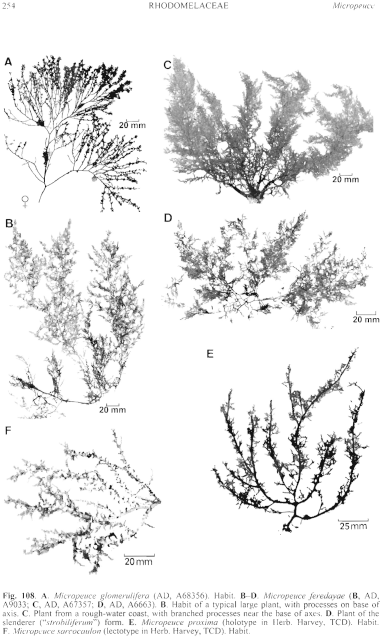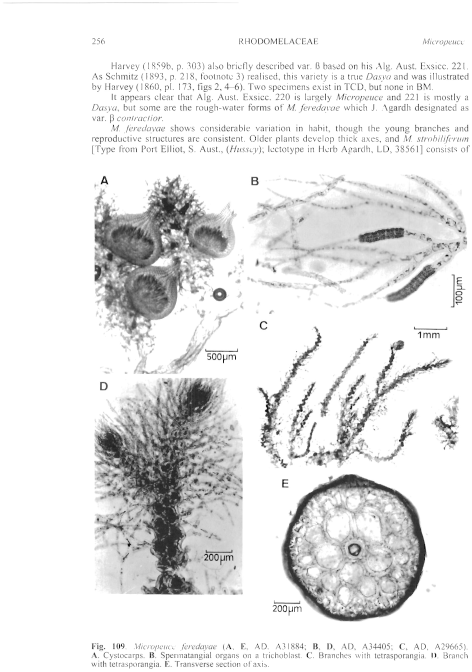|
|
|
|
|
|||||||||||
|
Electronic Flora of South Australia Species Fact Sheet
Phylum Rhodophyta – Family Rhodomelaceae – Tribe Lophothalieae
Selected citations: Kylin 1956: 511. May 1965: 379.
Synonyms
Dasya feredayae Harvey 1859b: 303; 1860: pl. 173 (habit only); 1863, synop.: xxiii. J. Agardh 1863: 1235. Sonder 1880: 36.
Dasya feredayae var. β contractior J. Agardh 1863: 1236.
Lophothalia feredayae (Harvey) J. Agardh 1890: 62. Wilson 1892: 165.
Brongniartella feredayae (Harvey) Schmitz 1893: 218. De Toni 1903: 1014. Guiler 1952: 104. Lucas 1909: 43; 1929a: 22. Womersley 1950: 186.
Micropeuce strobihferum J. Agardh 1899; 126, pl. 1 fig. 4 (4a partly incorrect). De Toni 1903: 1127; 1924: 430. Falkenberg 1901: 683. Kylin 1956: 511. Lucas 1909: 47. Lucas & Perrin 1947: 306. May 1965: 378. Shepherd & Womersley 1981: 367.
Brongniartella strobilifera (J. Agardh) Schmitz 1893: 218.
Thallus (Fig. 108B–D) dark red-brown, 8–30 (–50) cm high, much branched irregularly radially with a well developed, heavily corticated axis, usually branched in older plants, laterals branched for 2–4 orders, often proliferous from lower axes in larger plants. Upper branches clothed with trichoblasts for up to 2 cm from apices, denuded below, older axes smooth, 1–2 mm in diameter. Plants on rough-water coasts [var. β contractior J. Agardh (1863, p. 1236)] usually have the lower axes clothed with branched processes (Fig. 108C) 1–3 mm long, branches 100–300 µm in diameter. Holdfast discoid, 1–10 mm across; epilithic. Structure monopodial, trichoblasts cut off from segments 4–8 in spiral sequence, pericentral cells 5 (Fig. 109E), cut off from segments 8–15. Cortication commencing many segments below apices, with the pericentral cells remaining clear in transverse section and usually becoming thick walled, cortex small-celled. Trichoblasts rhodoplastic, 0.8–1.5 mm long, straight or often strongly incurved, branched several times 1–6 cells apart, tapering evenly from 30–50 µm in diameter below to 5–7 µm in subterminal cells (lost from older trichoblasts), basal cells L/D 1–1.5 (–2), mid cells L/D 2–3, upper cells L/D 4–10. Laterals arising on basal cells of trichoblasts. Cells uninucleate in trichoblasts; rhodoplasts discoid, becoming chained.
Reproduction: Gametophytes dioecious. Procarps on the next to basal cell of trichoblasts, which becomes polysiphonous. Carposporophytes with a basal fusion cell and much branched gonimoblast filaments with clavate terminal carposporangia 25–55 µm in diameter. Cystocarps (Fig. 109A) globose to urceolate, sessile, 600–1000 (–1200) µm in diameter, with a slight neck; pericarp ostiolate, 3–4 cells thick, corticated except on the neck. Spermatangial organs (Fig. 109B) on lower branches of trichoblasts, cylindrical, 100–220 (–300) µm long and 35–50 µm in diameter.
Tetrasporangia (Fig. 109D) borne in lesser branches (Fig. 109C) with trichoblasts, spirally arranged, one per segment, fertile parts (0.7–) 1–2 (–2.5) mm long and 150–300 µm in diameter; tetrasporangia 70–120 µm in diameter, with 3 cover cells.
Type from the Tamar, at Georgetown, Tas. (Harvey, Alg. Aust. Exsicc. 220); lectotype in BM.
Selected specimens: Eyre, W. Aust., drift (Parsons, 22.xi.1968; AD, A34405). Head of Great Australian Bight, S. Aust., drift (Parsons, 4.xi.1968; AD, A32949). Fishery Bay, Eyre Pen., S. Aust., drift (Parsons, 21.viii.1967; AD, A31884). Port Victoria, S. Aust., 3–4 m deep (Kraft, 20.ix.1973; AD, A44550). Investigator Strait, S. Aust., 27 m deep (Watson, 10.i.1971; AD, A38463). 20 km WSW of Outer Harbor, S. Aust., 22–25 m deep (McFarlane, 11.ix.1975; AD, A46622). Brighton, S. Aust., drift (Bienert, 12.xi.1965; AD, A29665). Port Noarlunga, S. Aust., 24 m deep (Ottaway, 3.ii.1981; AD, A52082). Port Elliot, S. Aust., drift (Womersley, 17.x.1948; AD, A9405). Vivonne Bay, Kangaroo I., S. Aust., lower eulittoral, shaded, inside Point Ellen (Womersley, 4.i.1990; AD, A60111). Pennington Bay, Kangaroo I., S. Aust., drift (Womersley, 4.i.1948; AD, A6663) and upper sublittoral pools (Womersley, 27.x.1995; AD, A64607). Blackfellows Caves, SE S Aust., drift (Loo, 3.xi.1997; AD, A67357). Queenscliff, Vic., drift (G. & R. Kraft, 12.xi.1997; MELU, K10841). Point Leo, Western Port, Vic., drift (Sinkora A1370, 29.x.1971; AD, A55586). Walkerville, Vic., drift (Womersley, 11.xi.1982; AD, A55354). Bridport, Tas., drift (Womersley & Parsons, 6.xi.1982; AD, A54544). Currie R., Tas., 2–10 m deep (G. & F. Perrin, Jan. 1937; AD, A9033). Middleton, Tas., (Perrin, Sept. 1940; HO, 47699).
Distribution: Eyre, W. Aust., to Western Port, Vic., and N Tasmania.
Taxonomic notes: Harvey (1859b, p. 303) based his Dasya feredayae on his Alg. Aust. Exsicc. 220, of which there are 4 specimens in BM, two of which are tetrasporangial, one is sterile (these 3 are Micropeuce), and another is a young sterile plant of Dasya haffiae. There is a single specimen (Micropeuce) in LD (42070) which is tetrasporangial, but none in TCD. Harvey recorded his material as sterile.
Harvey ( I 859b, p. 303) also briefly described var. 13 based on his Alg. Aust. Exsicc. 221. As Schmitz (1893, p. 218, footnote 3) realised, this variety is a true Dasya and was illustrated by Harvey (1860, pl. 173, figs 2, 4–6). Two specimens exist in TCD, but none in BM.
It appears clear that Alg. Aust. Exsicc. 220 is largely Micropeuce and 221 is mostly a Dasya, but some are the rough-water forms of M. feredayae which J. Agardh designated as var. β contractior.
M. feredayae shows considerable variation in habit, though the young branches and reproductive structures are consistent. Older plants develop thick axes, and M strobiliferum [Type from Port Elliot, S. Aust., (Hussey); lectotype in Herb Agardh, LD, 38561] consists of the slender, branched, laterals as often represented in drift specimens (Fig. 107D). Plants growing attached under turbulent conditions often display the short, lateral, appendages on the base of the axes.
References:
AGARDH, J.G. (1863). Species Genera et Ordines Algarum. Vol. 2, Part 3, pp. 787–1291. (Gleerup: Lund.)
AGARDH, J.G. (1890). Till algernes systematik. Acta Univ. lund. 26(3), 1–125, Plates 1–3.
AGARDH, J.G. (1899). Analecta Algologica. Cont. V. Acta Univ. lund. 35, 1–160, Plates 1–3.
DE TONI, G.B. (1903). Sylloge Algarum omnium hucusque Cognitarum. Vol. 4. Florideae. Sect. 3. pp. 775–1521 + 1523–1525. (Padua.)
DE TONI, G.B. (1924). Sylloge Algarum omnium hucusque Cognitarum. Vol. 6. Florideae. (Padua.)
FALKENBERG, P. (1901). Die Rhodomelaceen des Golfes von Neapel und der angrenzenden Meeres-abschnitte. Fauna und Flora des Golfes von Neapel. Monogr. 26. (Friedländer: Berlin.)
GUILER, E.R. (1952). The marine algae of Tasmania. Checklist with localities. Pap. Proc. R. Soc. Tasmania 86, 71–106.
HARVEY, W.H. (1859b). Algae. In Hooker, J.D., The Botany of the Antarctic Voyage. III. Flora Tasmaniae. Vol. II, pp. 282–343, Plates 185–196. (Reeve: London.)
HARVEY, W.H. (1860). Phycologia Australica. Vol. 3, Plates 121–180. (Reeve: London.)
HARVEY, W.H. (1863). Phycologia Australica. Vol. 5, Plates 241–300, synop., pp. i-lxxiii. (Reeve: London.)
KYLIN, H. (1956). Die Gattungen der Rhodophyceen. (Gleerups: Lund.)
LUCAS, A.H.S. & PERRIN, F. (1947). The Seaweeds of South Australia. Part 2. The Red Seaweeds. (Govt Printer: Adelaide.)
LUCAS, A.H.S. (1909). Revised list of the Fucoideae and Florideae of Australia. Proc. Linn. Soc. N.S.W. 34, 9–60.
LUCAS, A.H.S. (1929a). The marine algae of Tasmania. Pap. Proc. R. Soc. Tasm. 1928, 6–27.
MAY, V. (1965). A census and key to the species of Rhodophyceae (red algae) recorded from Australia. Contr. N.S. W. Natl Herb. 3, 349–429.
SCHMITZ, F. (1893). Die gattung Lophothalia, J. Ag. Ber. Deutsch. Bot. Ges. 11, 212–232.
SHEPHERD, S.A. & WOMERSLEY, H.B.S. (1981). The algal and seagrass ecology of Waterloo Bay, South Australia. Aquat. Bot. 11, 305–371.
SILVA, P.C., BASSON, P.W. & MOE, R.L. (1996). Catalogue of the Benthic Marine Algae of the Indian Ocean. (Univ. California Press: Berkeley.)
SONDER, O.W. (1880). In Mueller, F., Fragmenta Phytographiae Australiae. Supplementum ad volumen undecinum: Algae Australianae hactenus cognitae, pp. 1–42, 105–107. (Melbourne.)
WILSON, J.B. (1892). Catalogue of algae collected at or near Port Phillip Heads and Western Port. Proc. R. Soc. Viet. 4, 157–190.
WOMERSLEY, H.B.S. (1950). The marine algae of Kangaroo Island. III. List of Species 1. Trans. R. Soc. S. Aust. 73, 137–197.
The Marine Benthic Flora of Southern Australia Part IIID complete list of references.
Publication:
Womersley, H.B.S. (24 February, 2003)
The Marine Benthic Flora of Southern Australia
Rhodophyta. Part IIID. Ceramiales – Delesseriaceae, Sarcomeniaceae, Rhodomelaceae
Reproduced with permission from The Marine Benthic Flora of Southern Australia Part IIID 2003, by H.B.S. Womersley. Australian Biological Resources Study, Canberra. Copyright Commonwealth of Australia.
Illustrations in Womersley Part IIIA, 2003: FIGS 108 B–D, 109.

Figure 108 enlarge
Fig. 108. A. Micropeuce glomerulifera (AD, A68356). Habit. B–D. Micropeuce feredayae (B, AD, A9033; C, AD, A67357; D, AD, A6663). B. Habit of a typical large plant, with processes on base of axis. C. Plant from a rough-water coast, with branched processes near the base of axes. D. Plant of the slenderer ("strobiliferum") form. E. Micropeuce proxima (holotype in Herb. Harvey, TCD). Habit. F. Micropeuce sarcocaulon (lectotype in Herb. Harvey, TCD). Habit.

Figure 109 enlarge
Fig. 109. Micropeuce feredayae (A, E, AD, A31884; B, D, AD, A34405; C, AD, A29665). A. Cystocarps. B. Spermatangial organs on a trichoblast. C. Branches with tetrasporangia. D. Branch with tetrasporangia. E. Transverse section of axis.

|
Email Contact: State Herbarium of South Australia |

|